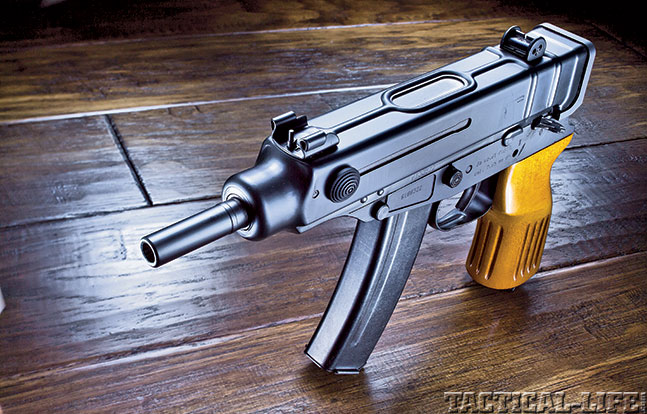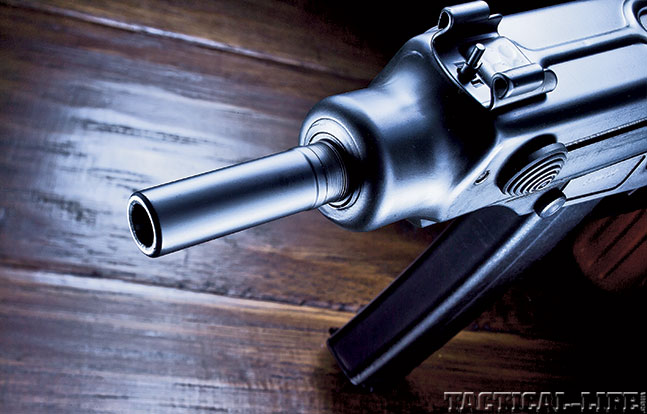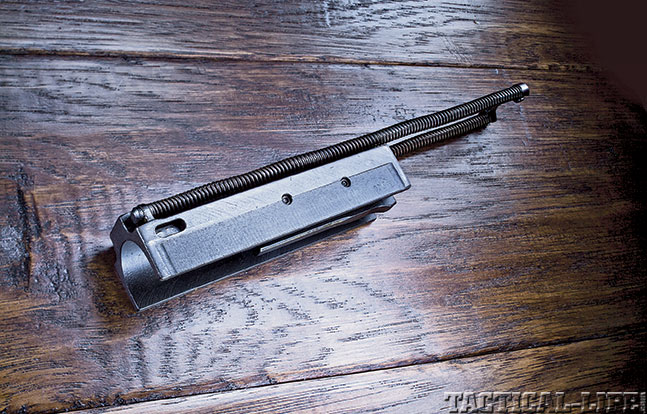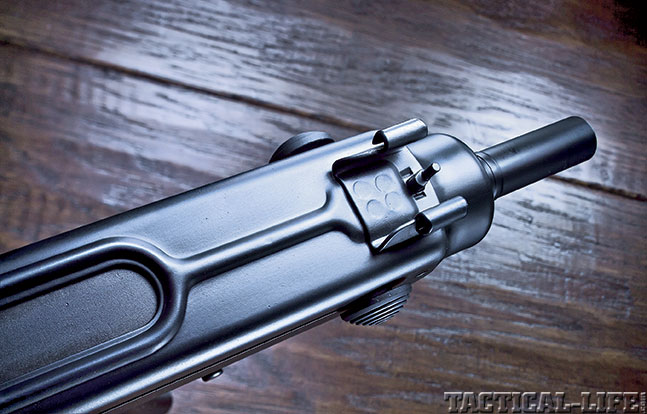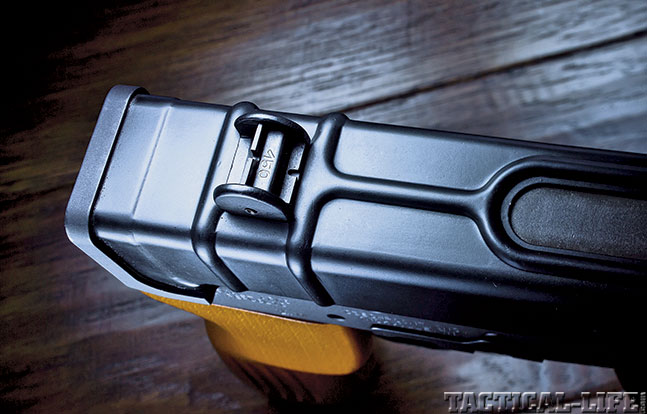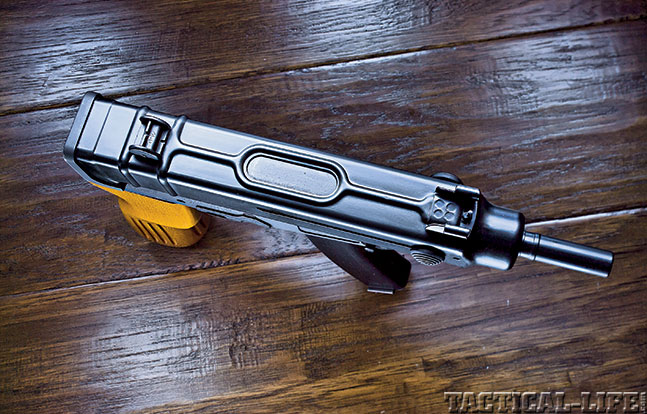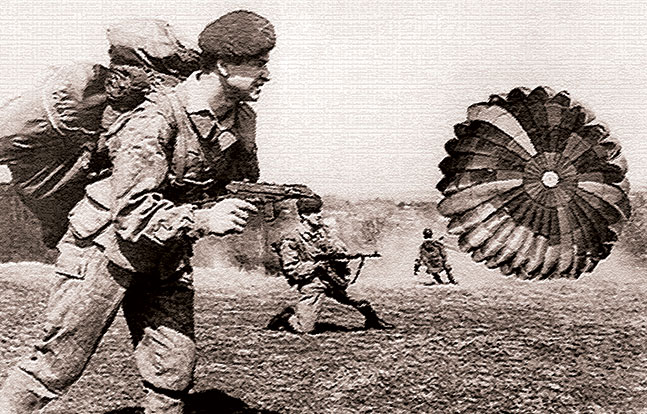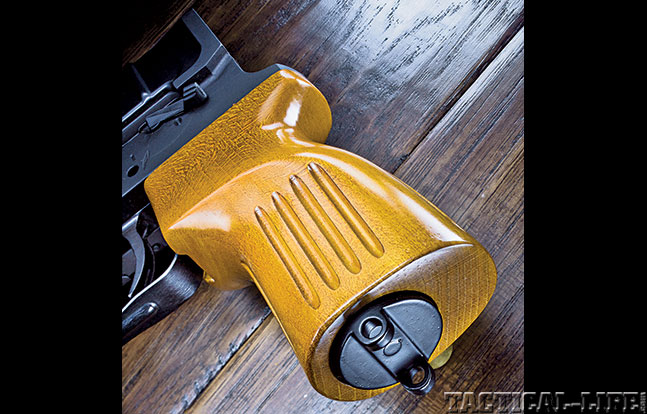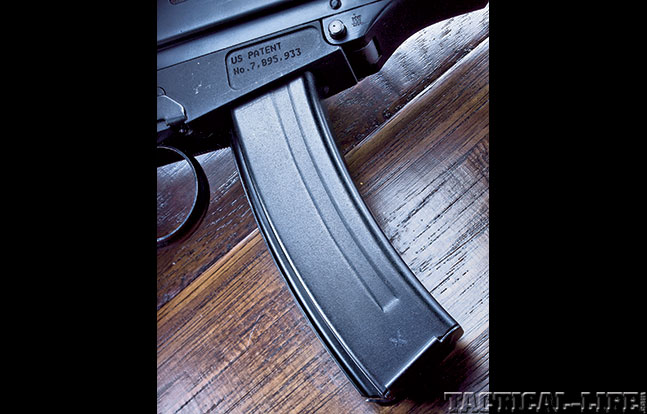The Czech Republic and Slovakia, once united under the flag Czechoslovakia, were both provinces of the Austro-Hungarian Empire until gaining independence in the aftermath of World War I. In 1919 the Jihoceská zbrojovka (South Bohemian Arms Factory) merged with the Hubertus Engineering firm to form the Ceská zbrojovka (Bohemian Arms Factory), better known by the initials CZ. The company’s first products were semi-auto pistols that used a rotating barrel system to lock the breech.
- RELATED: 7.62m Samopal VZOR 58
- RELATED: Megapistols: 7 Big Firearms in Small Packages – CzechPoint SA Vz. 58 5.56mm
In 1924, the Czechoslovakian Army adopted the CZ-designed Pistole vz. 24 (“vz” is short for vzor, which means “model” in Czech.) Chambered for the low-powered 9mm pistolový náboj (.380 ACP), it used the rotating barrel locking system. Three years later CZ introduced a blowback design, the Pistole vz. 27, chambered for the 7.65mm pistolový náboj (.32 ACP), which was adopted by the Czechoslovak Army and sold to police forces around the world.
During the German occupation of Czechoslovakia (1938 to 1945), the vz. 27 was manufactured in large numbers for the Wehrmacht, and post-war production continued until 1951 for police and commercial sale, with over a half million pistols eventually leaving the factory. The post-WWII Czechoslovakian Army intended to replace the ex-German and Soviet weapons in service with those of native design, but these plans where cut short by a 1948 coup that saw a communist government take power in Prague.
Advertisement — Continue Reading Below
Bowing to demands by the USSR for the standardization of small arms, the Czechoslovakians agreed to adopt Soviet-caliber cartridges while stubbornly clinging to their tradition of using weapons of native design. Thus, while other Warsaw Pact armies used the ubiquitous Soviet 7.62x25mm TT-33 Tokarev pistol, the Czechoslovakians developed the 7.62mm Samonabíjecí Pistole vz. 52 (7.62mm Semi-automatic Pistol Model 52).
In 1951, the Soviets adopted the Pistolet Makarova, a blowback-operated pistol with a double-action/single-action (DA/SA) trigger, and the Automaticheskij Pistolet Stechkina, a select-fire machine pistol with a detachable shoulder stock that doubled as a holster. Both were chambered for the 9x18mm Makarov cartridge. Needless to say, the Czechs were not impressed with either of these weapons, or their cartridge, and continued to issue the vz. 52. But they did see a tactical role for a weapon similar to the Stechkin, and in the usual, efficient Czech fashion went about designing one.
Advertisement — Continue Reading Below
Gun Details
As with the other Czech military and police arms, they turned to CZ, who assigned the project to engineer Miroslav Rybár. Between 1959 and 1961, Rybár developed a weapon that found approval and was adopted as the Samapol vz. 61 (Submachine Gun Model 61).
The vz. 61 was a blowback-operated, select-fire weapon built on a rectangular-shaped, stamped-steel receiver that contained the bolt and trigger mechanism and had a number of features that set it apart from most submachine guns of the time.
Advertisement — Continue Reading Below
“While originally intended for police and security personnel, the Czech Army found the vz. 61 a very attractive item.”
First of all, it fired from a closed bolt and was chambered for the 7.65mm pistolový náboj. This cartridge allowed the weapon to be of very compact size and produce lower recoil than 7.62mm or 9mm weapons. While the .32 ACP is not held in high esteem by American shooters, in Europe it was the primary police cartridge for the first eight decades of the 20th century, and it was also widely used by the military forces of many countries.
The vz. 61’s compact dimensions were achieved by using a telescopic bolt assembly that wraps around a considerable portion of the barrel, a feature the Czechs pioneered on their Sa vz. 48 (CZ 23) series of submachine guns, and it was also used on the Uzi and Beretta M12 submachine guns. The weapon features a spring-loaded case extractor installed inside the bolt head and a fixed double ejector, which is a protrusion in the weapon’s frame.
Advertisement — Continue Reading Below
As the bolt is relatively light, an inertial rate reducer housed inside the pistol grip lowers the rate of fire from 1,000 rounds per minute to a more manageable 850. The rate reducer operates as follows: When the bolt reaches the end of its rearward stroke, it strikes and is caught by a spring-powered hook mounted on the back plate. At the same time it drives a lightweight, spring-loaded plunger down into the pistol grip. The plunger is easily accelerated and passes through a heavy weight that is left behind because of its inertia. The plunger, having compressed its spring, is driven up again and then meets the descending inertia buffer. This slows down the rising plunger which, when it reaches the top of its travel, rotates the hook, releasing the bolt, which is driven forward by the compressed recoil springs.
“The vz. 61’s compact dimensions were achieved by using a telescopic bolt assembly that wraps around a considerable portion of the barrel.”
Dual cocking points ride in slots on both sides of the receiver and are serrated to allow a secure purchase when pulling the bolt to the rear. Detachable 10- and 20-round double-column magazines are inserted into the receiver in front of the triggerguard, and a safety/selector lever is located on the left side of the receiver above the pistol grip.
Advertisement — Continue Reading Below
An ejection port on top of the receiver allows spent cases to be thrown clear. While designed to be fired with two hands, the vz. 61’s small size allows the shooter to fire it one-handed if desired. Sights consist of a protected front post that can be adjusted for elevation while the U-notch rear sight has settings for 75 and 150 meters.
Among its other unique features is a wire shoulder stock that folds over the top of the receiver when not in use, which resulted in the weapon receiving the nickname “Scorpion.” This became so widespread that CZ used it in its advertising when it released the weapon on the commercial market.
While originally intended for police and security personnel, the Czech Army found the vz. 61 a very attractive item and issued it to staff officers, vehicle, artillery and aircraft crews, squad leaders, paratroopers and its 601st Special Forces Group.
Advertisement — Continue Reading Below
As with its other products, CZ released the vz. 61 on the world market, where it has seen service in nations ranging from Afghanistan to Indonesia to Mozambique. The communist Czechoslovakian government provided others to kindred groups in the name of “international socialist brotherhood,” and they were commonly seen in the hands of the various “national liberation” and terrorist groups in the Middle East, Africa, Asia and Latin America. The Yugoslavs found it attractive enough that they obtained a license from CZ to manufacture it as the Mašina kremenjak M.84.
Over the years, several versions of the Scorpion have been manufactured. In the 1990s, CZ offered the following submachine guns: the vz. 61 E (7.65mm version with a plastic pistol grip), the vz. 82 (chambered in 9mm Makarov with a 4.4-inch barrel) and the vz. 83 (chambered for the .380 ACP cartridge). A semi-auto version, the CZ-91S, was developed for the civilian market and offered in the above three chamberings and 9mm Luger. The Yugoslavs also manufactured a semi-auto version in 9mm Makarov as the M.84A.
Advertisement — Continue Reading Below
Range Time
Currently, a semi-automatic pistol version of the Scorpion, manufactured by Czech Small Arms in Jablunka in the Czech Republic, is imported by CzechPoint. Externally, it looks identical to its select-fire cousin, except it lacks the folding stock. Also, the rate reducer has been removed. I recently got my hands on this version of the Scorpion for a full test and evaluation at my local range.
CzechPoint’s website has the following statement regarding ammunition for the vz. 61: “It is recommended that 7.65mm Browning FMJ (round nose) be used to ensure excellent reliability during cycling. Our Scorpions utilize original CIP-spec 7.65mm Browning barrels. For this reason, CzechPoint does not recommend American manufactured (SAAMI-spec) ammunition as it may cause feeding issues. The following ammunition is recommended for the Scorpion as it is high quality and CIP-spec: Privi Partizan, Sellier and Bellot, or Fiocchi.”
Advertisement — Continue Reading Below
Fortunately, in the darker recesses of my landfill-like supply closet, I discovered several boxes of Fiocchi ammo. I threw the ammo in my truck with the vz. 61 and headed to my gun club to see if this malý ceský krásy (little Czech beauty) could do what was needed to be done.
To be honest about it, considering its rather crude sights, I found the vz. 61 to be quite accurate when fired from a rest at 25 yards. With a lowest sight setting of 75 meters, it tended to print a bit high, but once I had the “Kentucky elevation” figured out, I was able to consistently produce 10-shot groups ranging from 2 to 3.25 inches in size, printing dead on to point of aim.
The Fiocchi ammo ran with 100-percent reliability, and recoil was negligible, feeling similar to a .22 LR pistol. And while it ran 100-percent reliably, it threw empty cases straight up, many of which came back down on top of my head. I then set up a Dirty Bird combat target and proceeded to do some off-hand shooting from various distances, firing the vz. 61 with both supported and unsupported (one-handed) grips. Much to my delight, and despite its less than optimal sights, I managed to chew up the center of the target in a most pleasing manner.
The proper way to fire the vz. 61 with two hands is to place your support hand around the front of the magazine. Do not place it alongside the receiver or the dual cocking points will become dual pain inflictors! While it looks rather clumsy, it is easily fired one handed and actually balances quite well.
I ran about 250 rounds of Fiocchi ammo through it that afternoon without a single malfunction of any type, which is very commendable performance. One thing I found amusing is that the spent cases were ejected straight up in the air and as they descended produced a buzzing sound. Until we realized what it was I thought I had stepped into a hornet’s nest.
The CzechPoint Sa vz. 61 offers shooters a great opportunity to own their own version of this unique, classic machine pistol in civilian-legal, semi-automatic form.
For more information, visit czechpoint-usa.com.
